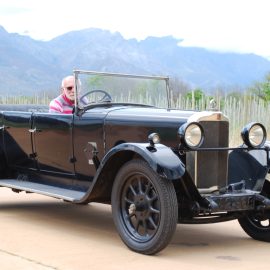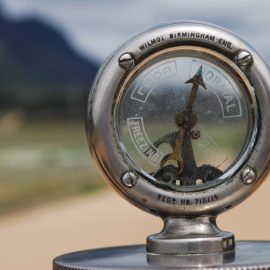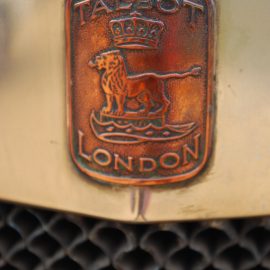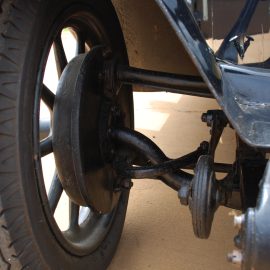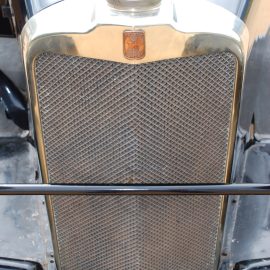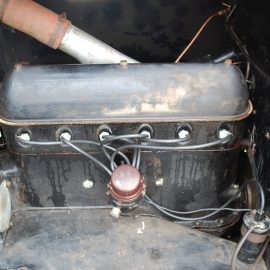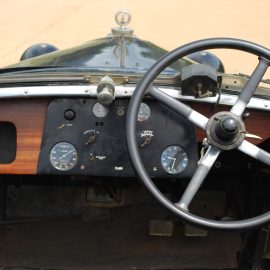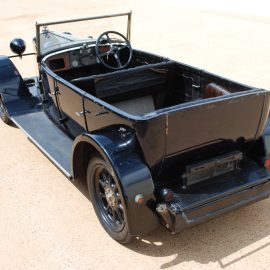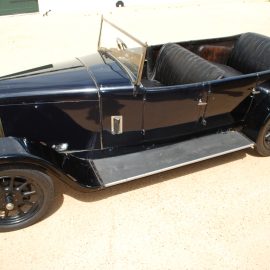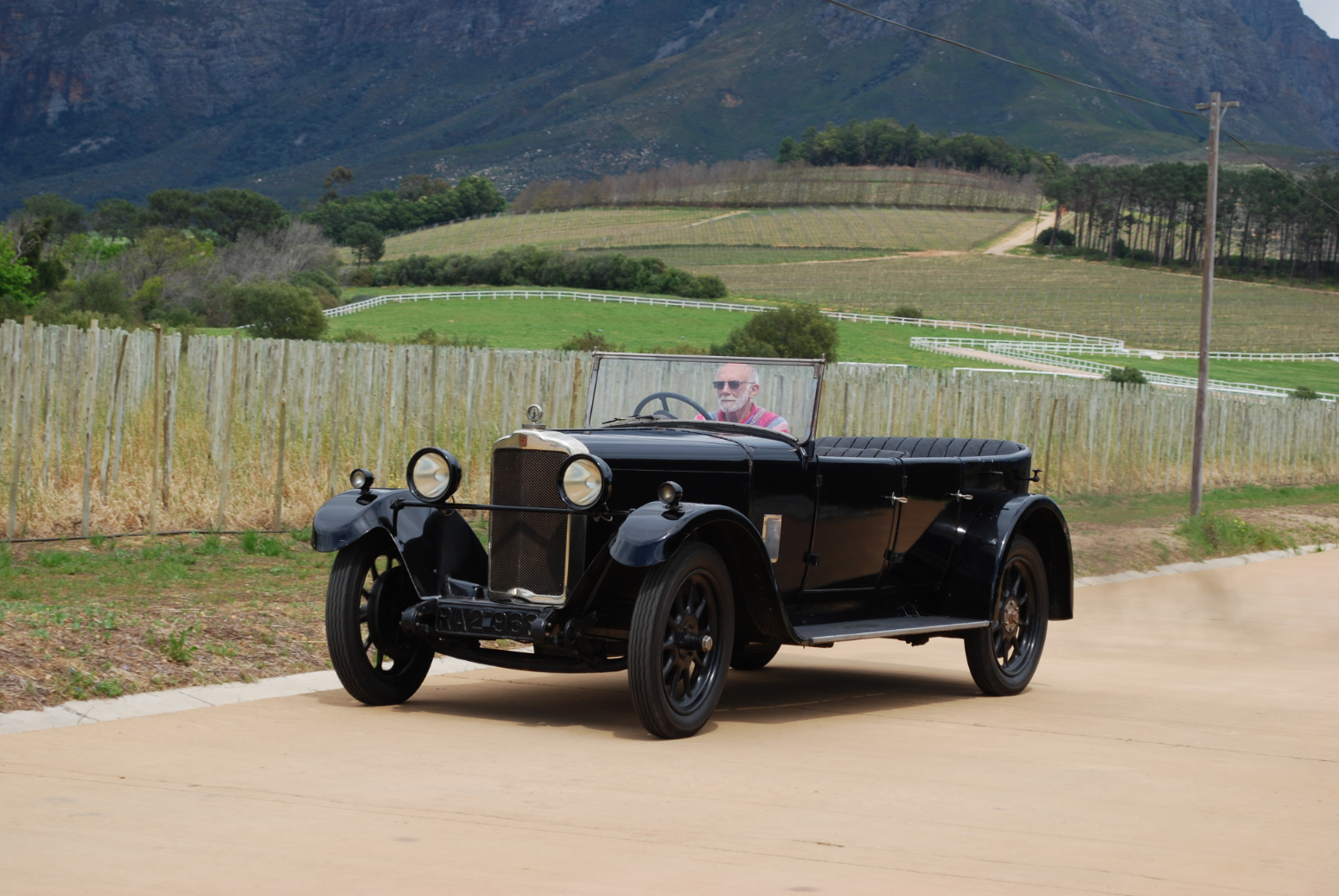
26 Nov Collection In Action: Talbot
A little battered and bruised maybe, but the attraction of this original 95-year-old Talbot is hard to resist, as Mike Monk explains…
The word ‘patina’ does not even come close to describing the character of this 1926 Talbot 14/45. Standing in the sunlight, its black paintwork dulled by years of exposure to the elements, the dings, scratches, tears and cracks demand respect rather than dismay as it awaits being called into action, warts and all. It represents the antithesis of molly-coddled concours machinery, and while not being at the pinnacle of the veteran, vintage and classic car movement – simply because of availability – vehicles in such original condition as this example are increasing in value (if that really matters). Clubs and enthusiasts around the world have recognised the material value of keeping a vehicle ‘as is’ and enjoying its virtues in ‘oily rag runs’, events open only to vehicles in original condition. And this Talbot is a (excuse the pun) classic example…
But before discussing the car, what about the name? Talbot was founded in 1903 with financial backing by British aristocrat Charles Chetwynd-Talbot, the 20th Earl of Shrewsbury. The company started out by importing French Clement-Bayard cars and branding them as Clement-Talbots. In 1905 assembly of the cars in a facility in Barlby Road, Ladbroke Grove, North Kensington, London and were sold simply as Talbots. No less than seven models were offered: designated by fiscal/actual horsepower ratings, the 8/10, 10/12, 12/16 and 20/24 were shaft driven, whereas the higher-powered 24/30, 35/45 and 50-60 were chain driven. By 1910 monthly sales were between 50 and 60 units. In 1913, a Talbot driven by Percy E Lambert became the first car to cover 100 miles (161 km) in an hour, an unwitting foretaste of the brand’s later sporting pedigree.
In 1916, the 25-year-old Swiss-German Georges Roesch became Talbot’s chief engineer as WWI raged, and the company manufactured ambulances for the war effort. The firm’s French and British operations continued in separate, parallel production and marketing processes until 1919, when British-owned but Paris based Darracq took over the company before Darracq was reorganised as part of the Sunbeam-Talbot-Darracq (STD) conglomerate the following year. Talbots continued to be made in London while Sunbeams were produced in Wolverhampton and Darracqs in Suresnes, in the western suburbs of Paris. Darracq-made Talbot models were marketed as Talbot-Darracqs.
In the early 1920s, Talbot built a number of successful models including the 14/45, which was first built in late-1926, beginning a line of models culminating in the 105. Despite sporting success in the 1930s (see tailpiece), in 1935 STD collapsed and the Sunbeam and Talbot marques were taken over by the Rootes Group. The French factory was bought by Anthony Lago, who created Talbot-Lago as a brand. Sunbeam-Talbot was formed in 1938 but production was halted during WWII, and the Talbot brand was dropped in 1955, with Sunbeam continuing until 1976.
Recognised by some as being the car that saved Talbot from obscurity, the 14/45 was launched at the 1926 London Motor Show and was mostly sold as an open two- or four-seater – but they were by no means sports cars. Having proven himself with development of the firm’s four-cylinder engine, for the 14/45 Roesch developed a new, long-stroke (95 mm) 1 666 cc in-line six-cylinder engine that featured a four-bearing (later seven-bearing) crank and a lightweight valve gear that featured vertical overhead valves operated by thin pushrods and rockers pivoting on friction-saving knife-edge fulcrums. The push-rods were made from Vibrac steel, the discovery of Armstrong, Whitworth Co. of Manchester, England. The metal was asserted to have “the valuable property of never tempering brittle and of being absolutely reliable and consistent in its behaviour under any normal treatment”. Not only that, the story goes that the push-rods were so light and thin for a car of its era because they were produced in a Birmingham knitting needle factory. The engine produced its 45 hp (35 kW) at 4 250 r/min, an engine speed it happily could maintain all day. It was one of first Talbot cars featuring a four-speed transmission and had a top speed of 62 mph (100 km/h).
As a fascinating aside, the engine of FMM’s car featured here was recently overhauled by one of Cape Town’s most respected ‘automobilists’, Dickon Daggitt. He was intrigued to find that valve clearance is controlled by buckets on top of the valve stems (á la Bugatti) as well as a V in a plug that is located in the rocker assembly. This plug is held in place by a bolt through the side that locks it to the rocker assembly. Dickon battled to set the clearances until he spoke with Feliciano Martins, who has the ex-Jock Boyd Talbot, who told him that that all he had to do was loosen the bolt, put a feeler gauge between the rocker and the valve stem, push down on the V-plug until all the clearances were taken up, then lock the bolt. Simple when you know how…
FMM’s Talbot – one of the earliest 14/45s to be built – was one of the first vehicles bought by British American Tobacco for the Heidelberg Motor Museum’s collection back in 1975. It came from British collector Patrick Chapman, and arrived pretty much in the condition it is in today and formed part of the museum’s core collection. FMM bought the car when Heidelberg was closed in October 2004. Nowadays, driving the car in all its natural glory; makes for an interesting experience. It starts immediately on the button and settles into a smooth rhythm. Alongside the handbrake, to the right of the footwell sprouts the gear lever with a well-worn ‘gate plate’, that facilitates precise engagement of the cogs. Pedals are conventionally laid out and while their action is stiff, they are not leg-achingly so. It pulls away with ease – the low-down torque of early long-stroke engines never ceases to amaze, often belying their cubic capacity – and once I had got the balance of revs/clutch/shift sorted, progress was (almost!) crunch free, helped by double-declutching on downshifts.
Devoid of hood and side glass, looking over the big steering wheel along the shapely bonnet, the radiator cap temperature gauge as doubled up as a ‘sight’ to the road ahead. It was easy to imagine being in the between-war years, bowling along to the purring accompaniment of the sweet exhaust, travelling the countryside and heading for a summer picnic spot with a full complement of passengers sharing the experience of the freedom of the road. The firm suspension and impressive brakes encouraged a ‘press on’ approach, with only the rather large turning circle (the wheelbase is 2 819 mm) needing consideration. An overheating coil temporarily brought our photoshoot to a halt, but no matter – ‘get out and get under’ as the old song advised.
The 14/45 was marketed as ‘the real sportsman’s car’ and, with 11 851 made, proved a commercial success at a crucial stage in the history of the Talbot concern. Sadly, it was not to last, but the charisma that surrounds the Talbot name seeps from every ding, scratch, tear and crack of this bare bones example. Now where is that oily rag…?
Tailpiece
Georges Roesch and the Invincible Talbots
In the 1930s, Talbots enjoyed great success in racing, rallies and trials, initially with the Fox & Nicholl team (with drivers including the Hon. Brian Lewis, Johnny Hindmarsh and John Cobb), and later with a team run by Warwick Wright together with numerous individuals. From the 14/45’s 1 665 cc engine, Roesch steadily developed the in-line six with a switch to a seven-bearing crank, changes to the cylinder head layout, the use of higher compression ratios, and increases to bore and stroke to enlarge swept volume, first to 2 276 and then 2 969 cc. Naturally, power figures increased with each progressive upgrade. Factory race cars employed special fuels to increase horsepower even further, up to 140 hp at the end. The cars began enjoying great success at events including the 500, 1000 and Double Twelve at Brooklands, Le Mans, the Tourist Trophy and the Irish GP, but with the most notable achievements taking place in the Alpine Trials. Two trios of works cars – the first road registered as GO 52, GO 53 and GO 54 and the second as BGH 21, BGH 22 and BGH 23, all of which survive to this day – helped the ‘Kensington Flyers’ to earn the accolade of ‘invincible’, a fine tribute to Roesch’s engineering skills.
FMM’s Talbot is currently on view in Hall C.




